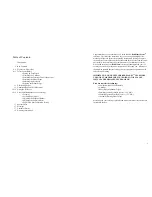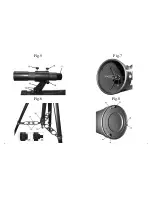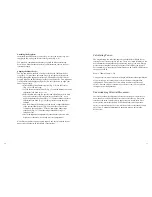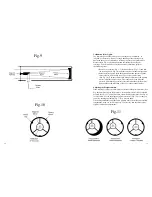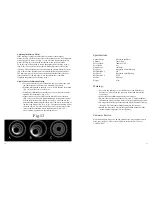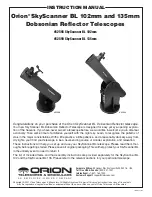
Using the Telescope:
Once you have properly assembled and aligned your telescope you are finally
ready to start using it.
• To locate an object using the telescope, first loosen the horizontal
lock knob (Fig. 1-7) and the altitude rod coarse adjustment lock knob
(Fig. 3-14) allowing the telescope to rotate along both axes. Look
through the finder scope (Fig. 1-1) to sight the object you are look
-
ing for and center it in the finder scope cross-hairs. You may need to
focus the finder scope by turning the finder scope focus knob (Fig.
5-17). Then re-tighten the horizontal lock knob and the altitude rod
coarse adjustment lock knob.
• Coarse altitude adjustments can be made by loosening the altitude
rod coarse adjustment lock knob (Fig. 3-14) and moving the tele
-
scope by hand. Finer altitude adjustments can be made by turning
the altitude rod fine adjustment control (Fig. 3-9).
• It is best to use the lowest power eyepiece (the Huygenian 20mm
eyepiece) at first. This allows for a wider field of view making it
easier to locate objects. Once the object is centered in the field of
view you can switch the eyepiece to higher magnifications.
• Once the object is centered in the field of view, turn the focus knobs
(Fig. 1-4) on the eyepiece focuser (Fig. 1-2) until the image is clear
and sharp.
• You will notice that the view through the finder scope and telescope
are normal, unlike other telescopes that have inverted images. This
normal view allows you to use this telescope for both terrestrial and
astronomical viewing.
• It is best to start by viewing terrestrial objects during the day. This
is a good way to practice observing with your telescope. At night it
is best to start by looking at the moon or other easy to find celestial
objects. As you become more experienced using your telescope you
can begin to try locating harder to find objects.
• If you are viewing celestial objects, you will notice that the object
will slowly move across the field of view (caused by the rotation of
the Earth). You will need to slowly move the telescope vertically
and/or horizontally to keep the object centered.
There are many conditions that may affect your ability to focus or observe
celestial objects clearly.
• Brightly lit areas (light pollution) will make it difficult to see faint
objects in the sky. It will also make it difficult for your eyes to adjust
to the dark. You should try and find a dark area and allow your eyes
to adjust to the dark before making observations. Using a red
filtered flashlight to view charts and your telescope components is
recommended to preserve your night sight. The best viewing
conditions are when the sky is inky black.
• Hazy skies, pollution, clouds and moisture can all affect the clarity
of your viewing image.
• Avoid touching the eyepiece or optical tube while looking through
the telescope. The vibrations caused by this contact will cause the
object you are looking at to move. You should also make sure that
the surface you place your telescope on does not vibrate or move as
this will also cause your viewing object to move.
• You should avoid setting up your telescope inside a room looking
through an open window. The difference in air temperatures may
result in a blurry image.
• Viewing through a closed window might also result in a distorted
image due to the varying densities of window glass.
• Avoid viewing objects that are low on the horizon. Objects that are
higher up in the sky will appear much sharper.
• Sudden changes in temperature may cause condensation to appear
on the optical components of the telescope. It is best to set up your
telescope ahead of time and then wait while the telescope adjusts to
the new temperature before using it.
Care and Maintenance of Your Telescope:
Cleaning:
• Always replace dust covers and lens caps when not in use. This will
minimize the amount of dust and debris that gets into your telescope.
• Cleaning should be performed only if absolutely necessary. If dust
has built up on the optics use a soft camel’s hair brush or pressurized
air to gently remove it.
• If dew collects on the optics of your telescope or moisture condenses
inside the optics, remove all accessories and place the telescope in a
dry, dust free environment and point the telescope downward.
This should help eliminate the moisture.
• Avoid touching the surface of the mirror.
• Do not attempt to take apart your telescope to clean it.
13
12
Summary of Contents for RP-100
Page 3: ...Fig 1 Fig 3 Fig 2 5 4 Fig 4...


